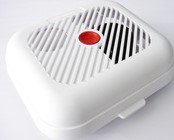Smoke Alarm Installation for Homes
The National Fire Protection Association’s NFPA 72: National Fire Alarm and Signaling Code sets forth their requirements for home smoke alarm installation. According to the organization, “NFPA 72 provides the latest safety provisions to meet society’s changing fire detection, signaling, and emergency communications demands.” The code has rules that “cover the application, installation, location, performance, inspection, testing, and maintenance of fire alarm systems.” Below are the NFPA’s smoke alarm installation recommendations for homes:
- Choose smoke alarms that have the label of a recognized testing laboratory.
- Install smoke alarms inside each bedroom, outside each sleeping area and on every level of the home, including the basement.
- On levels without bedrooms, install alarms in the living room (or den or family room) or near the stairway to the upper level, or in both locations.
- Smoke alarms installed in the basement should be installed on the ceiling at the bottom of the stairs leading to the next level.
- Smoke alarms should be installed at least 10 feet (3 meters) from a cooking appliance to minimize false alarms when cooking.
- Mount smoke alarms high on walls or ceilings (remember, smoke rises). Wall-mounted alarms should be installed not more than 12 inches away from the ceiling (to the top of the alarm).
- If you have ceilings that are pitched, install the alarm within 3 feet of the peak but not within the apex of the peak (four inches down from the peak).
- Don’t install smoke alarms near windows, doors, or ducts where drafts might interfere with their operation.
- Never paint smoke alarms. Paint, stickers, or other decorations could keep the alarms from working.
- For the best protection, interconnect all smoke alarms. When one smoke alarm sounds they all sound. Interconnection can be done using hard-wiring or wireless technology.
- When interconnected smoke alarms are installed, it is important that all of the alarms are from the same manufacturer. If the alarms are not compatible, they may not sound.
- There are two types of smoke alarms – ionization and photoelectric. An ionization smoke alarm is generally more responsive to flaming fires, and a photoelectric smoke alarm is generally more responsive to smoldering fires. For the best protection, both types of alarms or combination ionization-photoelectric alarms, also known as dual sensor smoke alarms, are recommended.
- Keep manufacturer’s instructions for reference.
Please keep in mind that requirements for smoke alarm installation vary depending on location. Consult your area’s fire department and a licensed electrician who is trained and expert in this field to ensure your home and family’s safety.
Electrical Peace of Mind
Providing professional electricians since 1988 in Maryland, Cook Electric is the company you can rely on for all your electrical service needs, including:
- Commercial & Residential Electrical Installations
- Marina & Residential Pier Wiring
- Electrical Service & Repair
- Specialty Electrical Services
For knowledgeable, fair, honest, reliable, and conscientious service, call Cook Electric today at 410-266-9040. They will be very glad to help you.

